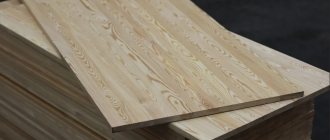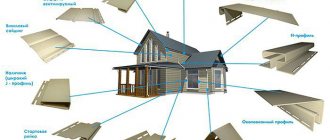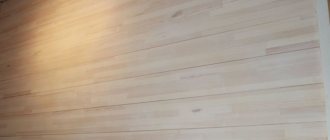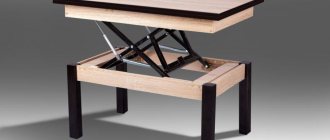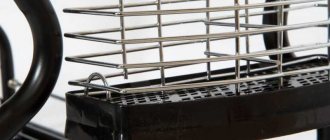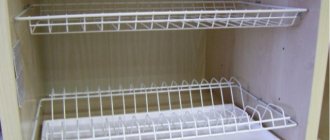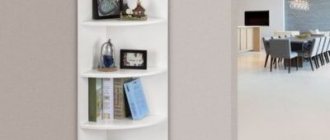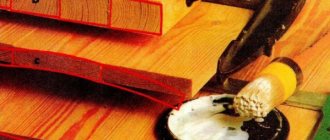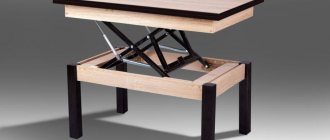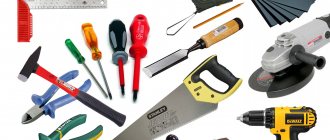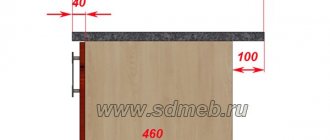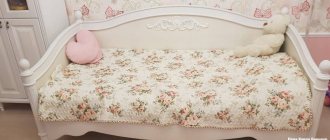Peculiarities
Pine furniture panels are popular among both builders and furniture makers. The production of products from pine material is accessible and low cost. Furniture panels are made from pine edged lumber with the addition of a binding component in the form of polymer adhesive compositions.
Pine material has a lot of positive properties:
- expressive natural wood texture;
- the ability to achieve a high degree of smoothness when grinding external surfaces;
- processing does not require the purchase of complex and expensive equipment;
- environmentally friendly and hypoallergenic.
Furniture pine panels are not prone to internal stress , so the material does not crack or warp over time. Coniferous wood has great potential for use. From this material you can make furniture for children and adults, perform interior decoration, produce windows, trim, and door panels. Pine wood is highly resistant to moisture, so it is used for finishing saunas and baths. It is not susceptible to mold, mildew and rot.
The cost of pine furniture panels depends on the class of the product and its dimensions.
Which material is better?
When choosing between wood products, you may be faced with a difficult question: “what is better – furniture board or chipboard?”, “what is stronger: furniture board or plywood?” The choice depends on the purpose of the purchase and financial capabilities:
Plywood.
Veneer sheets glued together in several layers. The strength of the material is comparable to natural solid wood. Plywood holds fasteners well and is highly wear-resistant. The scope of application is limitless. But due to its high strength and environmental friendliness, it is most often used for the production of children's furniture: high chairs, tables, cribs, chairs, cabinets, chests of drawers.
Chipboard.
The material is produced by pressing shavings and sawdust. Bulk elements are combined into a slab with formaldehyde resins. Stability is the main quality of chipboard. Thanks to him, wood panels are used in the manufacture of kitchen furniture. The main disadvantage is the short service life, no more than 10 years.
MDF.
Wood shavings and sawdust are pressed under high pressure. The boards are more environmentally friendly than chipboard. Adhesives of natural origin are used to glue the board components together. The products withstand high temperatures, humidity, and steam. For this reason, the material is often used for the production of kitchen furniture, bathroom and bedroom sets. The durability is low, like chipboard - about 10 years. Another disadvantage is that it does not hold fasteners and screws well.
As you can see, furniture panels are superior in many respects compared to other wood-based panels. Possessing all the advantages of natural solid wood, they have a long service life, are not too expensive in price, and are distinguished by high aesthetic properties.
Varieties
In the process of manufacturing furniture panels from edged lumber, various types of technologies are used. There are two options for pine panels:
- solid array of canvas;
- spliced view of the canvas.
Spliced glued furniture panels are divided into products:
- with a closed type of spike;
- with an open appearance of the thorn.
In addition, furniture panels are divided according to manufacturing technology:
- with single-layer fabric;
- with multi-layer fabric.
Furniture panels are also usually divided into types according to the method of application:
- solid lamella board - it is made by connecting individual long lamellas with an adhesive composition, the surface of such a board has the same strength as a solid slab;
- carpentry panel - its front surface is of low quality and requires additional processing.
Modern woodworking production can produce pine panels using various types of technologies depending on the quality of the raw materials. The starting material is usually trimmed natural wood.
Almost all pine products are made from Angara pine, which grows in the Krasnoyarsk Territory.
What is the difference between a solid-lamella furniture panel and a spliced one?
The main difference between these two types lies in the way the lamellas are connected:
- solid-lamella is a laminated array of solid bars, the length of which corresponds to the length of the shield;
- jointed is obtained by connecting small lamellas at the sides and ends, which is why it is often called “parquet”.
Solid lamella panels imitate the homogeneous structure of natural wood, unlike finger-jointed ones, they are less resistant to deformation. This fact is explained by the presence of a larger number of glued joints, which neutralize mechanical stresses in the material.
Classes
The cost of finished pine slabs depends on their classification by grade. Determination of grade is carried out by assessing the surface quality of the material. The material is marked in letters written with a fraction. For example, the notation A/C would mean that one side of the board is grade A, and the other side is grade C.
Furniture panels made of pine can be of several classes.
C
This grade allows for the presence of surface chips and cracks in the material, as well as a large content of large-sized knots. Furniture panels of this quality are used as blanks that will be veneered or laminated. Grade C material is used for construction needs or the construction of frames that will not be visible to prying eyes.
B
Furniture panels are made from connected lamella bars, which are not specifically selected for color shades and uniformity of texture. There may be minor flaws on the surface in the form of small cracks. Knots are present in the material, but their number is small. The material is used in the manufacture of furniture frame structures. The strength and reliability of the material provides it with a long period of operation.
A
Trimming material is selected according to color shade and texture. There should be no significant flaws or cracks on the surface of the shield. Knots can be present only in small quantities, their size should be minimal. The material is used to create external furniture structures and external parts.
Furniture panels of this quality have a balanced ratio between price and quality level.
Extra
The material consists of a solid lamellar fabric, where the components are selected according to the texture pattern and color shades. Such furniture panels do not have scratches, chips, or cracks . As a rule, the composition of the canvas is selected without knots; it uses the best selected wood raw materials. Before being released for sale, the shield undergoes a long and thorough finishing process. The cost of Extra class material is higher than all other analogues; the price can be compared with valuable wood species.
Colors
The uniqueness of the furniture board production technology is that it can be made from any type of wood that exists in the world. The resulting solid wooden canvas with a natural shade of texture will depend only on the type of wood from which the lumber was made.
The most common and affordable types of trees for making furniture panels are:
- pine, with shades of yellow-whitish sapwood, which during drying may darken slightly, taking on a brownish-red color;
- oak, which has a brownish or yellow-brownish texture with narrow yellow-white stripes;
- birch, which ranges in color from ivory to gray-red with a layered texture with small dark wavy lines,
- alder, which can have up to 30 reddish natural shades.
For the production of furniture facades, the following types of wood are often used:
- cherry or sweet cherry with a natural color in dark red tones with green splashes, expressed in the form of a pattern of parallel wavy lines;
- ash, reminiscent of oak structure, only slightly lighter with a matte gray or white tint;
- maple, which has hard wood with a beautiful texture of a light reddish color.
Characteristics of furniture panels
In order to correctly select material for further work, you need to have an idea of the characteristics. Furniture panels - you can also find the name “furniture board” - are divided into 2 large groups:
- solid lamella boards - characterized by the fact that the lamellas cut from the board are selected in one piece for the entire length of the finished product. You can also come across the term “monoblock”;
- the spliced type is when the lamella bars are spliced lengthwise.
Within the last group, several more types are distinguished, depending on the layers being fused:
- wood laminated;
- three-layer;
- with plywood inserts;
- with slatted inserts;
- Monoplasts are economical.
Three-layer
The characteristics and dimensions of furniture panels produced by manufacturers may have different effects on the areas of application and calculation of material consumption.
As an example, we can consider the possibilities of a shield on lamellas. In this case, the product may have the following set of characteristics:
- it will be made by connecting the lamellas in length or width. If the design involves laying out the lamellas relative to the width, they can have size ranges in millimeters: 100-110, 70-80, 40-45;
- if the slab was made in one piece, then the length of the sheet can be up to two meters, and if an assembly of lamellas was used, then up to five meters;
- the sheet thickness will be from 18 to 40 mm, but if the project requires, manufacturers can make other necessary options;
- The moisture level varies depending on the type of wood and batch, ranging from 6-12 percent. The optimal level is 8 percent;
- The quality of grinding is expressed in the degree of grit. The acceptable range is from 80 to 120 units.
Based on the characteristics parameters, you can choose the optimal option and dimensions, taking into account the subsequent finishing and processing of the finished product. Knowing the requirements for materials, you can choose the material wisely and thereby reduce financial costs and consumption. Remember that cheap product options may have shortcomings that will have to be addressed. Higher quality options are purchased in perfectly prepared condition.
Important physical and technical characteristics that provide a qualitative advantage of furniture boards over other types of materials include:
- high quality of compatibility with other types of materials;
- The surface of the boards is polished with high quality, so it is excellent for coating with both opaque and transparent compounds.
Furniture manufacturers choose this type of material when they plan to manufacture complex structures that are characterized by the presence of threaded connections, special cut shapes and complexity of fittings. Chipboard will not work here, but furniture panels will cope with the assigned tasks perfectly.
Where is it used?
The use of furniture panels has gained popularity in the creation of countertops and tables, as well as cabinets and kitchen facades. In structure they are close to wood. Products can be carved and milled. From thin shields you can make a beautiful carved screen for radiators or a screen.
Thick ones are suitable for making steps for stairs, window sills, shelving and storage systems. The use of the material is no less in demand in the field of interior decoration. The unusual pattern and structure of the spliced material, which resembles parquet, was used here.
Floors with this type of finish can be varnished, waxed and treated with impregnations. Finishing walls or creating partitions can also be done using furniture panels. If you need to make durable and soundproofing ceilings, such glued boards are perfect. Taking into account the recommendations given in the article, you can easily cope with the task of choosing the most suitable material for making interior items or finishing rooms.
Standard sizes
The dimensions of furniture boards are not regulated by GOST, however, manufacturers, when developing internal product standards, are based on consumer demand. Thus, we can say that the minimum possible slab size can be:
- length – 50 mm;
- width – 100 mm.
Despite the seemingly miniature dimensions, such a sheet is in great demand on the market, as it allows you to perform a wide range of tasks during construction and finishing work. The largest shield can reach dimensions of 5000x1200 mm. Such large sizes are ideal when finishing a large area. When purchasing such material, you will need high-quality equipment to make precise cuts.
Standard dimensions of furniture panels (mm):
- 600x1200, 2000, 2400, 2700;
- 500x1000, 1200, 2000, 2400, 2700;
- 400x600, 1000, 1200, 2000, 2400, 2700;
- 300x600, 800, 1000, 1200;
- 250x600, 800, 1000, 1200;
- 200x600, 800.
For convenience, manufacturers often use step-by-step gradation of furniture panel sizes. For example, in the range from 900 to 5000 mm, the length will change in increments of 100 mm.
Standard sizes
Width
The standard width of furniture panels is considered to be 200, 300, 400, 500 and 600 mm. This parameter determines whether the part will be solid or composite. If the width is planned to be non-standard, then the manufacturer and the customer will agree on the maximum deviations for the parameter. At the same time, making a shield from a board with a non-standard width will be more difficult than when using lamella bars. The most common parameters for furniture panels are:
|
|
|
The width of 250 mm is less common; we can say that this width is some deviation from the standard: 250x600, 800, 1000, 1200 mm.
Length
The length parameter of the furniture panel plays a role when it is necessary to calculate the height of the future product. If the base is a board that is connected along the length, such material will become a reliable basis for the body of future furniture.
A standard length furniture panel will be equal (in mm):
- 2000, 2400, 2700;
- 1000, 1200;
- 600, 800.
A construction furniture panel is considered to be a product with a length of 2000-4000 mm. Parameters equal to 800 and 2500 mm are also in great demand on the market.
Thickness
When it comes to the thickness of a furniture board, during its production it is imperative to take into account that the initial thickness of the boards will necessarily undergo planing and grinding, which will remove the top layer of material. The so-called 5 mm allowance will be removed in 2 stages. First, external defects are removed, and then the sheet will undergo finishing treatment so that the surface becomes perfectly smooth.
The thickness is selected depending on the purpose of the parts to be manufactured:
- 16 mm – facades, countertops, body parts, economy class;
- 18-20 mm – standard class. In addition to the above, headboards can be made;
- 30-40 mm – standard and luxury classes. Supporting and body parts, tabletops, seats, armrests.
Thickness is the main category that influences how the material is used. Moreover, the larger the parameter, the more expensive the lumber will be. A high-quality product can withstand a decent load, but if you choose it incorrectly, it is very likely that the shelf or the bottom of the drawer will break under the weight of things.
Custom sizes
Considering that each manufacturer initially approves its own specifications according to which it subsequently standardizes the production of furniture panels, in this case those that go beyond the previously regulated framework will be considered non-standard sizes. In this case, it will depend on the production capabilities of the enterprise and its equipment.
Non-standard sizes will be in demand for individual design projects that go beyond the required parameters in terms of use. An example would be mini versions of 50x100 mm, or a shield 5000 mm long with a standard parameter of 3500 mm.
Small caliber can be used for the manufacture of decorative or small furniture decoration elements. Large samples are used in the manufacture of cabinet and built-in furniture. A large sheet will have no seams, which means the surface will look as attractive as possible.
How to choose the right material
The choice is influenced by the class of material, that is, which one you need.
If you need shields of ideal quality, then it is better to choose class AA. After installation, no joints will be visible.
You can also choose BB grade shields. such material may have small healthy knots, but this is not significant. The surface is perfectly polished. For splicing, glue is used that does not emit toxic fumes.
Also, class AB is also considered a good option, since knots are only allowed on one side.
The most popular are sheets from coniferous trees and larch. These are inexpensive and high-quality options. They are mainly used for making slopes, window sills, tabletops, partitions, stairs, etc.
Luxury furniture is made from sheets made from species such as ash, beech or oak. The texture of this raw material is very beautiful.
Division into classes
As previously mentioned, there is no single GOST regarding the parameters of furniture panels. Each manufacturer, based on the existing standards GOST 8486-86 and GOST 2140-81, has the right to establish its own technical production conditions. Conventionally, furniture panels, regardless of the material, are divided into 4 classes, which can also be called grades;
- C class or Economy - a lamella or spliced type panel with small defects that do not have a significant effect on the overall mechanical properties of the product. These may be small spots, cracks, knots. Suitable for subsequent veneering and lamination;
- To class - allows only healthy knots to be present on the canvas. Made by splicing lamellas. They do not select textures and shades based on pattern;
- And the class is a spliced shield made of lamellas of the “spike” type. Knots and other wood defects must be absent. Uniformity of tone and character of the pattern are important;
- Extra class - a solid-lamella type shield, without defects and knots. Lamels are selected according to color, tone, texture.
Division into classes
It also happens that the two sides of one shield differ in class. In this case, they resort to fractional letter markings to designate each side of the shield to its class. For example: AB, BB, A/B, B/C. Mechanical damage to the slab is not allowed in any of the specified grades. Also, regardless of class, the panels are sanded and completely ready for coating.
The modern construction market offers a wide range of furniture panels that will help implement any furniture and interior decoration projects. A high-quality furniture panel will have a perfectly flat surface, which is perfect for painting or covering with a colorless transparent base. The main thing is to choose one that will fully correspond to the idea in terms of parameters and type of wood.
Elements for stairs, types of steps, platforms, beams:
For staircase elements (balusters, beams, steps, turning platforms and others) there is a similar classification.
But in addition to the AA and AB varieties, the Extra variety is also available.
- The “Extra” mark marks steps and turning platforms with a solid-lamella surface with a smooth structure of uniform color.
- Grade AA - mainly used on spliced type products. The surface has minimal natural errors.
- Grade AB – with darkening in the form of living fused knots. The most cost-effective option. Suitable for stairs in country houses.
Needles (Pine, Spruce)
General characteristics of pine/spruce furniture board:
- packaging - shrink film;
- humidity - 8-10%;
- weight of a dense cube - 400-500 kg;
- execution - spliced/solid-lamella;
- processing - polished surface, abrasive grain size - 80-120;
- adhesive connection class - D3;
- lamella width - 30-50 mm;
- Brinell hardness - Pine 1.6/Spruce 1.3;
- tolerances on geometric dimensions - width ±2 mm/length ±2 mm/thickness ±0.3 mm.
| Thickness: 14 mm Category: “ AB ” - solid (Door extensions) Material: Needles (Spruce, pine) | ||||||||
| Length, mm | Width, mm | |||||||
| 100 | 150 | |||||||
| 2200 | 150 rub. | 225 rub. | ||||||
| Thickness: 14 mm Category: “ AB ” - spliced (Wooden panel for walls) Material: Needles (Spruce, pine) | |||||||
| Length, mm | Width, mm | ||||||
| 220 | |||||||
| 2200 | 329 | ||||||
| 2500 | 373 | ||||||
| Thickness: 18 mm Category: “ AB ” - solid lamella Material: Needles (spruce, pine) | |||||||
| Length, mm | Width, mm | ||||||
| 200 | 250 | 300 | 400 | 500 | 600 | 800 | |
| 500 | — | 90 | 107 | 143 | 179 | — | — |
| 600 | 86 | 107 | 129 | 172 | 215 | 258 | — |
| 800 | 115 | 143 | 172 | 229 | 287 | 344 | 458 |
| 1000 | 143 | 179 | 215 | 287 | 358 | 430 | 573 |
| 1200 | 172 | 215 | 258 | 344 | 430 | 516 | 688 |
| 1500 | 215 | 269 | 322 | 430 | 537 | 645 | 860 |
| 1800 | 258 | 322 | 387 | 516 | 645 | 774 | 1 032 |
| 2000 | 287 | 358 | 430 | 573 | 716 | 860 | 1 146 |
| 2500 | 358 | 448 | 537 | 716 | 896 | 1 075 | 1 433 |
| 3000 | 430 | 537 | 645 | 860 | 1 075 | 1 290 | 1 719 |
* “Furniture panel Cat. AB (needles)". The quantity needs to be specified!
- 2000x1000x18 mm - 1,433 rubles/piece
- 2500x1000x18 mm — 1,791 RUR/piece
- 3000x1000x18 mm - 2,149 rubles/piece
| Thickness: 28 mm Category: “ AB ” - solid lamella Material: Needles (spruce, pine) | |||||||
| Length, mm | Width, mm | ||||||
| 200 | 250 | 300 | 400 | 500 | 600 | 800 | |
| 1000 | 223 | 279 | 334 | 446 | 557 | 669 | 892 |
| 1200 | 267 | 334 | 401 | 535 | 669 | 802 | 1 070 |
| 1500 | 334 | 418 | 501 | 669 | 836 | 1 003 | 1 337 |
| 1800 | 401 | 501 | 602 | 802 | 1 003 | 1 2044 | 1 605 |
| 2000 | 446 | 557 | 669 | 892 | 1 114 | 1 337 | 1 783 |
| 2500 | 557 | 697 | 836 | 1 114 | 1 393 | 1 672 | 2 229 |
| 3000 | 669 | 836 | 1003 | 1 337 | 1 672 | 2 066 | 2 675 |
* “Furniture panel Cat. AB (needles)"
- Size 3000x1000x28 mm - RUB 3,343/piece.
- Size 2000x1000x28 mm - RUB 2,229/piece.
| Thickness: 40 mm Category: “ AB ” - solid lamella Material: Needles (spruce, pine) | |||||||
| Length, mm | Width, mm | ||||||
| 200 | 250 | 300 | 400 | 500 | 600 | 800 | |
| 1000 | 318 | *P | 478 | *P | 796 | 955 | 1 274 |
| 1200 | 382 | 478 | *P | 764 | 955 | 1 146 | *P |
| 1500 | *P | *P | 716 | 955 | 1 194 | 1 433 | 1 910 |
| 1800 | *P | 716 | 860 | *P | 1 433 | 1 719 | 2 292 |
| 2000 | *P | *P | 955 | 1 274 | 1 592 | 1 910 | 2 547 |
| 2500 | *P | 995 | 1 194 | 1 592 | 1 990 | 2 388 | 3 184 |
| 3000 | 955 | 1 194 | 1 433 | 1 910 | 2 388 | 2 866 | 3 821 |
*p - this item is in the window sills section, the window sills are chamfered on one side
Pine
* “Furniture panel Cat. A (Pine).” The quantity needs to be specified!
- 2500x600x18 mm - RUB 1,431/piece.
- RUB 1,908/piece 2500x800x18 mm —
- RUB 1,717/pcs. 3000x600x18 mm -
| Thickness: 18 mm Category: “ Extra ” - spliced along the length (“ Natur ”) Material: pine | |||||||
| Length, mm | Width, mm | ||||||
| 200 | 250 | 300 | 400 | 500 | 600 | 800 | |
| 2000 | — | — | 475 | 634 | — | 950 | 1267 |
| 2500 | — | — | — | 792 | 990 | 1 188 | — |
| 3000 | 475 | — | — | 950 | 1 188 | 1 426 | 1 901 |
| Thickness: 18 mm Category: “ Extra ” – length-joined Material: pine | |||||||
| Length, mm | Width, mm | ||||||
| 200 | 300 | 400 | 500 | 600 | 800 | 1200 | |
| 2000 | — | — | 719 | — | — | — | 2 697 |
| 2500 | 450 | 674 | 899 | — | 1 349 | — | 2 697 |
| 2900 | — | — | — | — | 1 564 | — | — |
| 3000 | 200 | — | — | — | 1 798 | — | — |
| Thickness: 40 mm Category: “ Extra ” – length-joined Material: pine | |||||
| Length, mm | Width, mm | ||||
| 250 | 400 | 500 | 600 | 800 | |
| 2500 | — | — | — | 2 997 | — |
| 3000 | — | 2 398 | 2 997 | — | — |
We are ready to produce the following types of shields:
- solid EXTRA made from 40 mm bars - an elite and most expensive material;
- one-piece EXTRA SANDWICH made of two panels 20+20mm - the material is clean on both sides;
- one-piece EXTRA/BC SANDWICH - two panels 20+20 II - bottom with defects and top clean;
- solid AB from a 40 mm bar - bitches and sapwood are allowed;
- solid SANDWICH AB - two panels 20+20 mm - material on both sides with live skeins and possibly sapwood;
- solid SANDWICH AB/BC - two panels 20+20 mm - bottom with defects, top - live knots;
- one-piece aircraft;
- spliced EXTRA;
- spliced SANDWICH EXTRA / BC;
- fused AB;
- spliced aircraft;
Birch
General characteristics of common birch furniture panels:
- packaging - shrink film;
- humidity - 8-10%;
- weight of a dense cube - 600-700 kg;
- execution - spliced;
- processing - polished surface, abrasive grain size - 100-120;
- adhesive connection class - D3;
- lamella width - 35-50 mm;
- Brinell hardness - 3.5;
- tolerances on geometric dimensions - width ±2 mm/length ±2 mm/thickness ±0.3 mm;
- size range - length 1000-3000 mm/width 200-1000 mm.
| finger-jointed Extra/A – Birch Furniture Panel – thickness 18 mm | |||
| Length, mm | Width, mm | Execution | price, rub. |
| 1800 | 700 | 2 016 | |
| 2000 | 700 | 2 240 | |
| 2500 | 400 | 1 600 | |
| Extra/A solid-lamella Furniture Board Birch - thickness 18 mm | |||
| Length, mm | Width, mm | Execution | price, rub. |
| 1800 | 600 | 1 944 | |
| 2000 | 600 | 2 160 | |
| 2300 | 600 | 2 484 | |
| 2500 | 600 | 2 700 | |
| 2800 | 600 | 3 024 | |
| 2900 | 600 | 3 132 | |
| Extra/A solid-lamella Furniture Board Birch - thickness 20 mm | |||
| Length, mm | Width, mm | Photo | price, rub. |
| 1000 | 600 | 1 200 | |
| 1000 | 800 | 1 600 | |
| 1200 | 600 | 1 440 | |
| 1200 | 800 | 1 920 | |
| 1500 | 600 | 1 800 | |
| 2000 | 600 | 2 400 | |
| 2200 | 600 | 2 640 | |
| 2400 | 400 | 1 920 | |
| 2800 | 500 | 2 800 | |
| 2800 | 600 | 3 360 | |
| 2900 | 600 | 3 480 | |
| 3000 | 600 | 3 600 | |
| Birch Furniture Board, finger-jointed - thickness 28 mm | ||||
| Thickness, mm | Length, mm | Width, mm | Category | price, rub. |
| 28 | 2000 | 800 | Extra/A | 4 000 |
| 2500 | 800 | 5 000 | ||
| 2800 | 600 | 4 200 | ||
| 3000 | 400 | 3 000 | ||
| 3000 | 500 | 3 750 | ||
| 3000 | 600 | 4 500 | ||
| 3000 | 700 | 5 250 | ||
| 3000 | 800 | 6 000 | ||
| 3000 | 1000 | 7 500 | ||
| Furniture Board Birch - thickness 40 mm | |||||
| Thickness, mm | Length, mm | Width, mm | Category | Execution | price, rub. |
| 40 | 2800 | 600 | Extra/Spliced | spliced | 5 376 |
| 3000 | 600 | Extra/brindle | 5 040 | ||
| 1000 | 600 | Extra/solid | whole | 2 220 | |
| 1000 | 800 | 2 960 | |||
| 1200 | 800 | 3 552 | |||
| 38 | 1300 | 400 | 1 924 | ||
| 1500 | 600 | 3 330 | |||
| 2800 | 500 | 5 180 | |||
Beech
General characteristics of beech furniture board:
- packaging - shrink film;
- humidity - 8-10%;
- weight of a dense cube - 600-700 kg;
- execution - spliced/solid-lamella;
- processing - polished surface, abrasive grain size - 100-120;
- adhesive connection class - D3;
- lamella width - 30-50 mm;
- Brinell hardness - 3.8;
- tolerances on geometric dimensions - width ±2 mm/length ±2 mm/thickness ±0.2 mm.
| Furniture panel spliced Beech Extra “Tiger” - thickness 20mm | |||
| Thickness, mm | Length, mm | Width, mm | price, rub. |
| 20 | 1500 | 600 | RUR 2,160 |
| 2000 | 600 | RUR 2,880 | |
| 2500 | 600 | RUB 3,600 | |
| 2500 | 800 | 4,800 rub. | |
| 3000 | 200 | RUR 1,440 | |
| 3000 | 600 | RUB 4,320 | |
| 3000 | 800 | RUB 5,760 | |
| Furniture panel spliced Beech Extra “Tiger” - thickness 25mm | |||
| Thickness, mm | Length, mm | Width, mm | price, rub. |
| 25 | 1500 | 400 | 1,500 rub. |
| 1500 | 600 | RUR 2,250 | |
| 2000 | 600 | 3,000 rub. | |
| 2500 | 600 | RUB 3,750 | |
| 2500 | 800 | 5,000 rub. | |
| 3000 | 600 | 4,500 rub. | |
| 3000 | 800 | 6,000 rub. | |
Production technology
Let's try to figure out composite furniture board - what it is and how it is made. The production process consists of several stages:
- Raw wood is cut into boards.
- The resulting boards are dried until the moisture content drops to 6-8%.
- The boards are “cut” - cut into lamellas.
- Then the lamellas are assembled into a sheet and glued together.
- The layer obtained from the bars is pressed.
- After pressing, the material is processed by planing on all sides.
- The layer is cut to the required size and trimmed to length.
- The resulting shields are polished on a machine. Packed in film.
Oak
General characteristics of oak furniture panels:
- packaging - shrink film;
- humidity - 8-10%;
- weight of a dense cube - 650-720 kg;
- execution - spliced/solid-lamella;
- processing - polished surface, abrasive grain size - 100-120;
- adhesive connection class - D3;
- lamella width - 35-50 mm;
- Brinell hardness - 3.8;
- tolerances on geometric dimensions - width ±2 mm/length ±2 mm/thickness ±0.2 mm;
- size range - length 1000-3000 mm/width 200-1000 mm.
| Furniture Panel Oak Extra - thickness 20/22 mm | ||||
| Thickness, mm | Length, mm | Width, mm | Execution | price, rub. |
| 20 | 1000 | 600 | solid-lamella | 3 120 |
| 1000 | 800 | 4 160 | ||
| 1200 | 600 | 3 744 | ||
| 1200 | 800 | 4 992 | ||
| 1300 | 400 | 2 704 | ||
| 1300 | 600 | 4 056 | ||
| 1400 | 800 | 5 824 | ||
| 1500 | 400 | 3 120 | ||
| 1500 | 600 | 4 680 | ||
| 1500 | 800 | 6 240 | ||
| 1600 | 600 | 4 992 | ||
| 1800 | 400 | 3 744 | ||
| 1800 | 600 | 5 616 | ||
| 2000 | 600 | 6 240 | ||
| 2200 | 600 | 6 864 | ||
| 2500 | 600 | 7 800 | ||
| 2700 | 600 | 8 910 | ||
| 2800 | 600 | 9 240 | ||
| 2900 | 400 | 6 380 | ||
| 2900 | 600 | 9 570 | ||
| 2900 | 620 | 9 889 | ||
| 3000 | 600 | 9 900 | ||
| 1500 | 800 | spliced | 3 480 | |
| 2000 | 400 | 2 320 | ||
| 2000 | 600 | 3 480 | ||
| 2000 | 620 | 3 596 | ||
| 2000 | 800 | 4 640 | ||
| 2500 | 400 | 2 900 | ||
| 3000 | 400 | 3 480 | ||
| 3000 | 600 | 5 220 | ||
| 3500 | 600 | 6 090 | ||
| 3500 | 800 | 8 120 | ||
| 22 | 3000 | 1200 | spliced | 10 440 |
| Furniture Panel Oak Natur jointed - thickness 20-25 mm | |||
| Thickness, mm | Length, mm | Width, mm | price, rub. |
| 20 | 2000 | 400 | 2 240 |
| 2500 | 200 | 1 400 | |
| 2500 | 400 | 2 800 | |
| 2500 | 600 | 4 200 | |
| 25 | 2000 | 400 | 2 400 |
| 2000 | 600 | 3 600 | |
| 2500 | 400 | 3 000 | |
| 2500 | 600 | 4 500 | |
| 2500 | 800 | 6 000 | |
| 3000 | 400 | 3 600 | |
| 3000 | 600 | 5 400 | |
| 3000 | 800 | 7 200 | |
| solid lamella - thickness 40 mm Furniture Panel Oak Extra | |||
| Thickness, mm | Length, mm | Width, mm | price, rub. |
| 40 | 900 | 300 | 2 025 |
| 1000 | 1000 | 10 000 | |
| 1200 | 600 | 6 336 | |
| 1300 | 400 | 4 576 | |
| 1500 | 400 | 5 580 | |
| 1500 | 600 | 8 370 | |
| 1600 | 600 | 8 928 | |
| 1600 | 800 | 11 904 | |
| 1800 | 600 | 10 044 | |
| 1800 | 800 | 13 392 | |
| 2000 | 400 | 7 440 | |
| 2000 | 600 | 11 160 | |
| 2000 | 620 | 11 532 | |
| 2000 | 800 | 14 880 | |
| 2000 | 1000 | 20 000 | |
| 2100 | 600 | 11 718 | |
| 2300 | 600 | 12 834 | |
| 2500 | 600 | 13 950 | |
| 2500 | 800 | 18 600 | |
| 2600 | 400 | 10 192 | |
| 2700 | 400 | 10 584 | |
| 2800 | 600 | 16 464 | |
| 3000 | 400 | 11 760 | |
| 3000 | 600 | 17 640 | |
| Furniture Panel Oak Extra finger-jointed - thickness 40 mm | |||
| Thickness, mm | Length, mm | Width, mm | price, rub. |
| 40 | 2500 | 600 | 9 000 |
| 2500 | 800 | 12 000 | |
| 2500 | 1000 | 15 000 | |
| 3000 | 600 | 10 800 | |
| 3000 | 800 | 14 400 | |
| 4000 | 600 | 14 400 | |
| Glued laminated timber Extra Oak | |||||
| Thickness, mm | Width, mm | Length, mm | Execution | Photo | price, rub. |
| 100 | 100 | 3000 | spliced | 4 500 | |
Larch
General characteristics of larch furniture board:
- packaging - shrink film;
- humidity - 8-10%;
- weight of a dense cube - 650-700 kg;
- execution - spliced/solid-lamella;
- processing - polished surface, abrasive grain size - 80-120;
- adhesive connection class - D3;
- lamella width - 30-50 mm;
- Brinell hardness - 2.6;
- tolerances on geometric dimensions - width ±2 mm/length ±2 mm/thickness ±0.2 mm;
- size range - length 1000-3000 mm/width 200-1000 mm.
| Furniture Panel Larch Extra/A – thickness 18 mm | ||||
| Thickness, mm | Length, mm | Width, mm | Execution | price, rub. |
| 18 | 2400 | 600 | spliced | 2 304 |
| 2500 | 2 400 | |||
| 3000 | 2 880 | |||
| 1500 | 600 | solid-lamella | 1 890 | |
| 2000 | 600 | 2 760 | ||
| 2400 | 600 | 3 312 | ||
| 2500 | 600 | 3 675 | ||
| 3000 | 600 | 4 410 | ||
| Furniture Panel Larch Extra/A – thickness 40 mm | ||||
| Thickness, mm | Length, mm | Width, mm | Execution | price, rub. |
| 40 | 1000 | 600 | solid-lamella | 2 640 |
| 1200 | 600 | 3 168 | ||
| 1500 | 600 | 3 960 | ||
| 1500 | 800 | 5 280 | ||
| 2000 | 600 | 5 880 | ||
| 2000 | 800 | 7 840 | ||
| 2500 | 600 | 8 025 | ||
| 2500 | 800 | 10 700 | ||
| 3000 | 600 | 9 630 | ||
| 3000 | 800 | 12 840 | ||
| 2000 | 600 | spliced | 4 140 | |
| 2000 | 800 | 5 520 | ||
| 2500 | 600 | 5 175 | ||
| 3000 | 600 | 6 210 | ||
| Extra spliced larch beam | ||||
| Thickness, mm | Width, mm | Length, mm | Photo | price, rub. |
| 80 | 80 | 3000 | 1 500 | |
| 100 | 100 | 3000 | 2 500 | |
Ash
General characteristics of Ash furniture panels:
- packaging - shrink film;
- humidity - 8-10%;
- execution - spliced/solid-lamella;
- processing - polished surface, abrasive grain size - 80-120;
- adhesive connection class - D3;
- lamella width - 30-50 mm;
- tolerances on geometric dimensions - width ±2 mm/length ±2 mm/thickness ±0.2 mm;
- size range - length 1000-3000 mm/width 200-1000 mm.
| Furniture Panel Ash Extra - thickness 20 mm | ||||
| Thickness, mm | Length, mm | Width, mm | Execution | price, rub. |
| 20 | 1000 | 600 | solid-lamella | 2 520 |
| 1200 | 600 | 3 024 | ||
| 1300 | 600 | 3 276 | ||
| 1500 | 600 | 3 780 | ||
| 2000 | 600 | 5 040 | ||
| 2500 | 600 | 6 300 | ||
| 2700 | 600 | 6 804 | ||
| 2900 | 600 | 7 308 | ||
| 3000 | 600 | 7 560 | ||
| 3000 | 600 | spliced | 5 400 | |
| Furniture Panel Ash Extra - thickness 28 mm | ||||
| Thickness, mm | Length, mm | Width, mm | Execution | price, rub. |
| 28 | 1200 | 600 | solid-lamella | 3 888 |
| 1600 | 600 | 5 184 | ||
| 1800 | 600 | 5 832 | ||
| 2000 | 600 | 6 480 | ||
| 2300 | 600 | 7 452 | ||
| Furniture Panel Ash Extra - thickness 40 mm | ||||
| Thickness, mm | Length, mm | Width, mm | Execution | price, rub. |
| 40 | 1400 | 600 | solid-lamella | 6 640 |
| 1500 | 600 | 7 110 | ||
| 2000 | 600 | 9 480 | ||
| 2100 | 600 | 9 954 | ||
| 2500 | 600 | 11 850 | ||
| 2800 | 600 | 13 272 | ||
| 3000 | 600 | spliced | 9 360 | |
You can find out about the availability of goods in stock by calling:
+7,, +7 (926) 715-97-50
Order products in our online store:
Storage of products.
Glued natural wood must be stored under the following conditions:
- Temperature 20° ±5°
- Relative humidity 65 ±10%
- No direct sunlight
- Storage in packaging!
After complete removal of the packaging material, it is necessary to cover the laminated wood product with moisture-repellent impregnations or coatings within 10 hours to maintain moisture inside the wood. Glued products should not be placed near heating devices until they are covered with paints and varnishes. It is stored for a long period of time exclusively “lying” to preserve the required geometry.
Where can I buy?
Of course, when choosing furniture panels, it is also important to pay attention not only to the size, type and material of the wood, but also to its quality, manufacturer, humidity (should be minimal so that the product does not deteriorate during operation).
You can purchase beautiful and high-quality panels made from solid oak, beech, ash, and pine on our website. We select only the best lumber and woodworking products for our customers. They work with us and trust us!
Our advantages:
- Favorable delivery in Chelyabinsk,
- Great prices. Including wholesale.
- A wide range of.
Still have questions? Ask our specialists! Leave a request on the website - we will contact you shortly.
